It would have been nice to get more than this 6-paragraph minimalist treatment of the ideas in this post. Steve Wheeler argues that "Almost always, social presence is a deciding factor in whether students persist in their remote studies, or whether they give up." Can teaching or cognitive presence make up for this (see, for example, the CoI model from the late 90s). And if presence is grounded in the various affordances of techning technologies, shouldn't we be designing with affordances, rather than learning objectives, in mind (as I have suggested)?
Web: [Direct Link] [This Post]Rolandt
Shared posts
Reflections Week Two: pace yourself
The reason I'm posting this particular post in this particular newsletter is for the summary of Phipps's contribution to a Dave Cormier webcast with a single quip: “Whatever you do digitally, it’s going to be more accessible to your students than not doing it.” It's easy to think of online learning as substandard, or of your own contributions as not enough, but it's false thinking. In my own work, I have always positioned my thinking from the perspective of the average person who cannot afford university tuitions, not the elite who can. The comparison isn't between $50K education and online learning, it's between online learning and nothing. Today, everybody is in that boat, but the basic logic doesn't change.
Web: [Direct Link] [This Post]Stephen Downes formulates an important point, e...
Stephen Downes formulates an important point, especially now that so many are working and learning from home.
“It’s easy to think of online learning as substandard, or of your own contributions as not enough, but it’s false thinking. In my own work, I have always positioned my thinking from the perspective of the average person who cannot afford university tuitions, not the elite who can. The comparison isn’t between $50K education and online learning, it’s between online learning and nothing. Today, everybody is in that boat, but the basic logic doesn’t change.”
It chimes with my perspective on agency, and how to push tech, tools and knowledge to those for whom the existing stuff has too high a threshold. Distributed digital transformation to build up networked agency.
Liked Reflections Week Two: pace yourself by Stephen DownesThe reason I'm posting this particular post in this particular newsletter is for the summary of Lawrie Phipps's contribution to a Dave Cormier webcast with a single quip: “Whatever you do digitally, it’s going to be more accessible to your students than not doing it.”
Regarding Zoom

A good summary of the reasons why I prefer not to use Zoom at all (and only do it via a private mode web browser now).
COVID-19 Journal: Day 10
Twitter Favorites: [Tinfoiling] Going to try something different on my blog. https://t.co/afyJgkiQFZ
Unmasking Twitter
On March 16 Twitter posted An Update on Our Continuity Strategy During COVID-19 that included this bit on how the company was changing its policies about content moderation:
Broadening our definition of harm to address content that goes directly against guidance from authoritative sources of global and local public health information. Rather than reports, we will enforce this in close coordination with trusted partners, including public health authorities and governments, and continue to use and consult with information from those sources when reviewing content.
So what is the latest guidance from authorities? The World Health Organization (WHO) helpfully has a tweet:
When to use mask
• If you are healthy, you only need to wear a mask if you are taking care of a person with suspected #coronavirus infection.
• Wear a mask if you are coughing or sneezingMore https://t.co/4odGgqxAKP#COVID19 pic.twitter.com/1aM8MyaSmF
— World Health Organization (WHO) (@WHO) March 1, 2020
So does the CDC:
CDC does not have updated guidance scheduled to come out on this topic. See current CDC guidance regarding the use of facemasks: https://t.co/DiX7VzdqDp
— CDC (@CDCgov) March 28, 2020
So does the U.S. Surgeon General:
Seriously people- STOP BUYING MASKS!
They are NOT effective in preventing general public from catching #Coronavirus, but if healthcare providers can’t get them to care for sick patients, it puts them and our communities at risk!
https://t.co/UxZRwxxKL9— U.S. Surgeon General (@Surgeon_General) February 29, 2020
What I thought was particularly noteworthy, though, was this tweet from the Surgeon General yesterday:
WHO stands by recommendation to not wear masks if you are not sick or not caring for someone who is sick – CNN https://t.co/SZmvX3CWMi
— U.S. Surgeon General (@Surgeon_General) March 30, 2020
Everyone is taking their guidance from the WHO, and that’s a problem.
WHO and China
The Wall Street Journal, in an article in February, explored why the WHO seems to act with such deference to China.
When the World Health Organization declared a global public-health emergency at the end of last month, it praised China’s “extraordinary” efforts to combat the coronavirus epidemic and urged other countries not to restrict travel. “China is actually setting a new standard for outbreak response,” WHO Director-General Tedros Adhanom Ghebreyesus said. Many governments ignored the travel advice. Other public-health experts criticized his unqualified praise for China.
Among the complaints directed at Dr. Tedros: He was bending to Beijing by lauding a Chinese response that included quarantining 60 million people—which many health experts see as inconsistent with WHO guidelines—while calling on other countries not to cut off travel and trade with China…By praising China’s response effusively, the WHO is compromising its own epidemic response standards, eroding its global authority, and sending the wrong message to other countries that might face future epidemics, they say…
Dr. Mackenzie questioned why Chinese authorities appeared to delay reporting an increase in infections in the first half of January. Many health experts believe the outbreak spread more quickly early on because local authorities tried to cover it up, including by reprimanding a local doctor who sought to raise the alarm, and then were slow to announce it could pass person to person. “China is obviously an important player,” said Dr. Mackenzie. “So everything the WHO does has to keep that in mind. At the same time, you can be overly effusive.”
The entire article is well worth a read, but the takeaway is this: at every step of this outbreak the WHO has sought to praise and accommodate China, despite the fact that news about the initial outbreak was forcibly suppressed, the fact that China violated WHO guidelines with the severity of its quarantines (which to be clear, appear to have been effective), the fact that China hid the transmission rate amongst health care workers from the WHO until February 14 and waited weeks to even allow the WHO into the country, and only then on carefully scripted and chaperoned tours.
Those tours — which again, took weeks to negotiate, even as the coronavirus was spreading all over the globe — resulted in this report. It is, indeed, exceptionally effusive of the Chinese response, and contains no mention of China’s cover-up of human-to-human transmission in particular, which led to this tweet from the WHO:
Preliminary investigations conducted by the Chinese authorities have found no clear evidence of human-to-human transmission of the novel #coronavirus (2019-nCoV) identified in #Wuhan, #China
. pic.twitter.com/Fnl5P877VG
— World Health Organization (WHO) (@WHO) January 14, 2020
This was particularly unfortunate given that Taiwan had told the WHO on December 31 that there was human-to-human transmission.
At the same time, much of the report is genuinely useful, particularly this warning to other countries:
COVID-19 is spreading with astonishing speed; COVID-19 outbreaks in any setting have very serious consequences; and there is now strong evidence that non-pharmaceutical interventions can reduce and even interrupt transmission. Concerningly, global and national preparedness planning is often ambivalent about such interventions. However, to reduce COVID-19 illness and death, near-term readiness planning must embrace the large-scale implementation of high-quality, non-pharmaceutical public health measures. These measures must fully incorporate immediate case detection and isolation, rigorous close contact tracing and monitoring/quarantine, and direct population/community engagement.
Had this been heeded by Western countries, all would be in far better shape than they are.
Asymptomatic Transmission
Even so, it might not have mattered, because of this paragraph:
Asymptomatic infection has been reported, but the majority of the relatively rare cases who are asymptomatic on the date of identification/report went on to develop disease. The proportion of truly asymptomatic infections is unclear but appears to be relatively rare and does not appear to be a major driver of transmission.
This is problematic in three ways:
- First, it is at odds with evidence from the Diamond Princess (where every member of the population was tested), Iceland (where a statistically representative sample of the entire population has been tested), and South Korea (where testing was widely available even without symptoms); all show a high rate of asymptomatic infection.
- Second, there are multiple | reports | from | China that asymptomatic carriers spread the virus.
- Third, there is compelling statistical evidence that asymptomatic carriers drove the majority of the virus’s spread within China (and likely, by extenstion, around the world). This, notably, suggests that social distancing and travel bans are particularly effective.
It seems likely this paragraph about the lack of asymptomatic transmission was strongly argued for by China. Caixin reported at the beginning of March about China’s push in this area:
China’s decision to exclude individuals who carry the new coronavirus but show no symptoms from the country’s public tally of infections has drawn debate over whether this approach obscures the scope of the epidemic, with a document received by Caixin showing a significant proportion of one province’s cases show no symptoms. Since early February, the National Health Commission (NHC) has concluded that “asymptomatic infected individuals” can infect others and demanded local authorities to report those cases. However, the commission has also decided not to include these people in its statistics for “confirmed cases” or indeed to release data on asymptomatic cases.
In an interview with Nature last week, Wu Zunyou, China’s chief epidemiologist, defended the country’s treatment of asymptomatic data. He told the magazine that a positive nucleic acid test — a genetic sequencing test used to detect the coronavirus — does not necessarily indicate an infection because viral genetic material detected through throat or nasal swabs does not confirm the virus has entered cells and begun to multiply. This notion was also echoed by Chinese representatives at the WHO.
But this view has been challenged by both domestic and overseas experts, who said that a virus must have replicated to reach detectable levels.
I am no expert, but given that a virus cannot replicate on its own, but rather must leverage the body’s cells to churn out copies of itself, it seems rather self-evident that if it is detectable it has entered cells. And yet, Director General Tedros Adhanom Ghebreyesus argued — on Twitter! — that asymptomatic carriers were not a concern:
“Evidence from
is that only 1% of reported #COVID19 cases do not have symptoms & most of those cases develop symptoms within 2 days.
Some countries are looking for cases of COVID-19 using surveillance systems for influenza & other respiratory diseases”-@DrTedros #coronavirus
— World Health Organization (WHO) (@WHO) March 3, 2020
Again, an increasing amount of evidence is that this just isn’t true: asymptomatic carriers are a major problem.
Mask Efficacy
This is where masks come in. Much of the discussion of their efficacy has been focused on whether they keep you safe from the virus, and the evidence suggests that the answer is probably. SlateStarCodex has a comprehensive overview of the evidence here.
Everyone agrees, though, that those who are sick should wear masks; as the Taiwan CDC puts it, “Masks are mainly used for preventing the spread of disease and protecting people around you.” This, though, highlights the shortcomings of the “Don’t wear masks if you’re not sick” recommendations:
- First, people are terrible in general at estimating if they are sick, particularly if their symptoms are mild.
- Second, as Zeynep Tufekci argued in the New York Times, saying that only sick people should wear them stigmatizes the sick and makes them less likely to wear them.
- Third, and most importantly, asymptomatic transmission means you don’t even know if you are sick in the first place.
This point was well-made by Sui Huang on Medium:
There is no scientific support for the statement that masks worn by non-professionals are “not effective”. In contrary, in view of the stated goal to “flatten the curve”, any additional, however partial reduction of transmission would be welcome — even that afforded by the simple surgical masks or home-made (DIY) masks (which would not exacerbate the supply problem). The latest biological findings on SARS-Cov-2 viral entry into human tissue and sneeze/cough-droplet ballistics suggest that the major transmission mechanism is not via the fine aerosols but large droplets, and thus, warrant the wearing of surgical masks by everyone.
This is where China’s push to exclude asymptomatic cases is so damaging: it excluded what may be the most important SARS-CoV-2 transmission vector, which resulted in the WHO not updating its guidelines, which may have resulted in far more people in the West getting sick than might have otherwise.
The good news is that the authorities appear to be listening: the Washington Post is reporting that the CDC is considering revisiting its guidelines, and suggesting that people use nonmedical masks or cloth coverings (because N95 masks and surgical masks should be reserved for healthcare workers); Austria already made masks compulsory, joining Slovakia, the Czech Republic, and Bosnia-Herzegovina (masks are, of course, widespread in most of Asia, although, contrary to popular belief, not compulsory by law, although often enforced by private businesses). Germany is considering the same.
To be very clear, N95 masks and even surgical masks, at least until they are widely available, should be saved for healthcare workers. That’s ok though: homemade masks work, and governments should be honest about that.
Twitter’s Theoretical Value
Twitter, in its guidelines, lists multiple examples of when it might enforce its new policy. The third one stood out:
Description of harmful treatments or protection measures which are known to be ineffective, do not apply to COVID-19, or are being shared out of context to mislead people, even if made in jest, such as “drinking bleach and ingesting colloidal silver will cure COVID-19.”
It sure seems like multiple health authorities — the experts Twitter is going to rely on — have told us that masks “are known to be ineffective”: is Twitter going to delete the many, many, many tweets — some of which informed this article — arguing the opposite?
The answer, obviously, is that Twitter won’t, because this is another example of where Twitter has been a welcome antidote to “experts”; what is striking, though, is how explicitly this shows that Twitter’s policy is a bad idea, not just because it allows countries like China to indirectly influence its editorial decisions, but also because it limits the search for truth.
You can think about the value of disagreeing with experts theoretically. Suppose that experts are correct 9 out of 10 times (and honestly, that’s probably low). However, if they are wrong, they have to pay out $100 (if they are right, they don’t get anything, because that is how the world works; the payout comes from being an expert in the first place). In this case, the expected cost of being an expert is:
9 x $0 + 1 x $100 = $100
-$100: yes, you may be right most of the time, but when you get it wrong, it is going to cost you.
Now, suppose experts have to put up with Twitter and having people question them. It’s a real pain in the rear end, what with all of the trolls and misinformation. To that end, let’s suppose every episode now costs the expert $5 because they have to argue with people who aren’t experts. This suggests the cost is:
10 x $5 + 1 x $100 = $150
The problem is that this overlooks the possiblity that the non-experts are sometimes right, or, perhaps more realistically, that they force the experts to re-visit their assumptions and predictions. Suppose that 10% of the time they are actually useful; now the expected cost is:
10 x $5 + 90%(1 x $100) = $140
Better than the worst case scenario, but not great.
That, though, isn’t quite right either, because it misses the fact that on a medium like Twitter, there are effectively infinite counter-arguments — indeed, that is why Twitter is so costly ($5) in the first place! The pay-off, though, is that the right argument is that much more likely to surface — let’s say 90% of the time. Now the expected cost is:
10 x $5 + 10%(1 x $100) = $60
That is a big improvement over the base case!
These numbers are, obviously, completely made up, but frankly, I think they are conservative. The cost of the coronavirus crisis in particular is so astronomical that basically any amount of investment to have avoided it or to ameliorate it is well worth it. Masks, hopefully, will be a good example: if Twitter is right, and the CDC is wrong, and economies are able to open sooner than they might have otherwise, that will be well worth all of the misinformation and terrible takes that Twitter produced in the meantime.
Internet Optimism
There is a further, even more optimistic, takeaway. In the analog world, politicians and experts needed the media to reach the general population; debates happened between experts, and the media reported their conclusions. Today, though, politicians and experts can go direct to people — note that I used nothing but tweets from experts above. That should be freeing for the media in particular, to not see Twitter as opposition, but rather as a source to challenge experts and authority figures, and make sure they are telling the truth and re-visiting their assumptions.
Indeed, while many on the right gripe that the media’s general opposition to Trump is driven by partisanship, I actually think it is a healthy approach to authority in general, particularly when that authority doesn’t need help going directly to people. Imagine if the media applied the same skepticism they give to Trump to the CDC or WHO, much less the Obama administration’s approach to the Great Financial Crisis or the Bush administration’s approach to Iraq (or, for that matter, Chinese data).
As I have argued from the beginning of this site, the Internet is an amoral force: it is up to us to decide if it is for good for bad. The best way forward is embracing Internet assumptions and using the overwhelming amount of information and free access to anyone to make things better, not try and build a moat around what experts say is right or wrong.
I wrote a follow-up to this article in this Daily Update.
Moving Online in Pandemic #5: This is the time of creative destruction
TRY TRY TRY TRY
For five glorious Tuesdays in the summer of 2011 I walked from our apartment on Graefestrasse and walked through Kreuzberg to Druckwerkstatt where I would design, set, and print something.
I would arrive in the print shop with an empty mind and a blank canvas, and emerge, 6 or 7 hours later, with a thing. It the annals of my creativity it was a summer to bookmark.
I woke up this morning to an email from a friend that was so full of light that some of it spilled over into me. And it is Tuesday. So I rousted myself up earlier than has been my pandemic habit, and got to the print shop by 9:30 a.m. With a blank canvas.
As I stood in front of the type cabinet, wondering what to do, I looked over at a collection of bits and bobs yet to be sorted and saw T, Y, and R, three wood letters that were a gift last summer from my friend Martin.
T Y R.
T R Y.
Go!

I squirted a squirt of yellow ink onto the platen, such a pleasure, as it’s an intense yellow, the kind of yellow that you could live inside if you had to:

I flipped the motor on the letterpress on and let the rollers quietly do their work turning the squirt into a sheen:

While this was happening, I took some letter-sized card stock and cut down each sheet into four to make postcard-sized cards:

And when that was done, I set the type; not hard to do with just three letters:

I mounted the chase in the press, put in a piece of scrap paper, and made my first TRY:
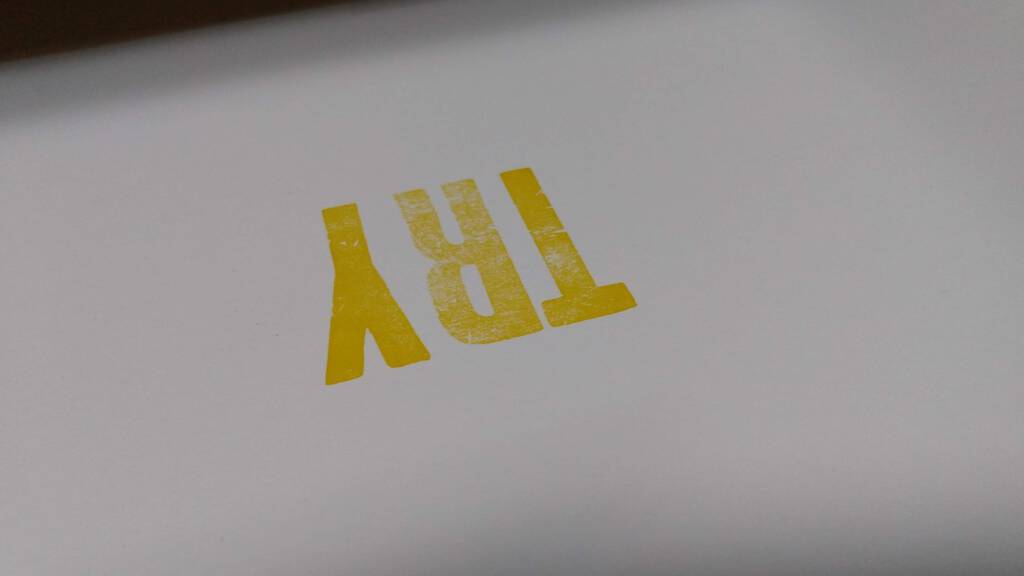
This is always the most uncomfortable time of the printing process for me: imperfection. The T and R are too close together. The T and the Y are heavier than the R. And there’s not enough ink. This purgatory makes me nervous, and I set quickly to work to get closer to heaven through the makeready.
First, I buttressed the R with a rectangle of tissue paper taped underneath:

I added a shim between the T and the R to add some air, added a squidge more yellow ink, and added some additional packing to get a more satisfying print. The evolution was more satisfying:
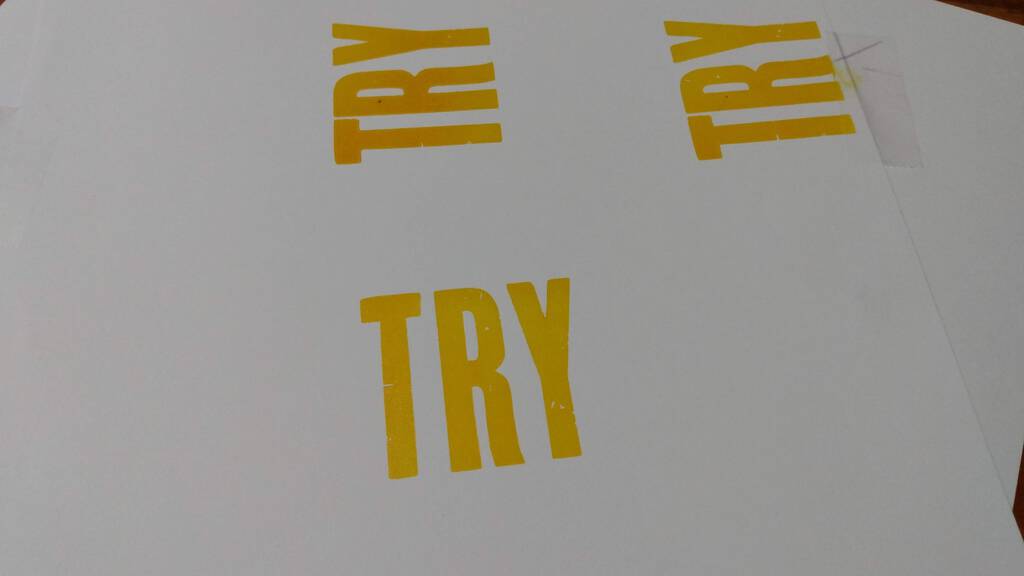
Even more so on a postcard:

It’s hard to shoot video and to print at the same time while also staying safe, but here’s a glimpse at what printing a TRY looks like:
I was ready to print in earnest!
I zeroed the counter:

And I printed. When I was done I had 50 TRYs to dry:
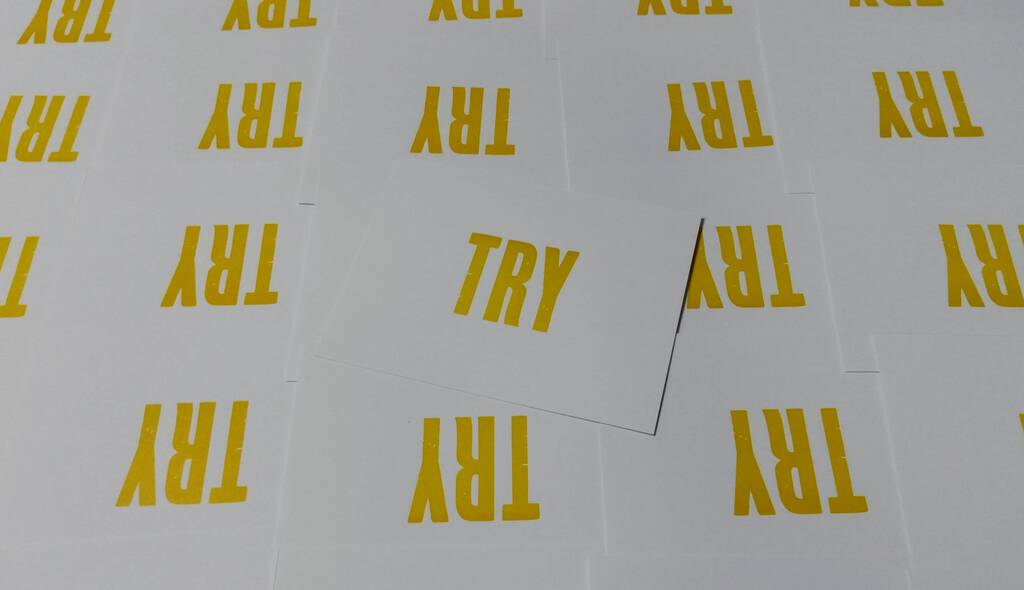

Would you like a TRY? Email me your name and postal address and I’ll put one in the mail as soon as they’re dry.
that thing where you read a random quote and decide it's a metaphor for the state of the world
I had a giant freak-out yesterday afternoon. And then I watched The Wailing (2016) with my mom in the evening.
My mom is like a shark in that she’s always moving and will likely rip a chunk out of anyone who gets in her way. Like a shark in a tank, she's become increasingly restless from being cooped up in the apartment lately. She’ll mope around while I’m working, complaining to the dogs that I won’t watch a movie or play cards with her.
I signed up for Shudder last week with the ‘rona promo code, and my mom loves horror, so after I logged off from work yesterday I asked if she wanted to watch something with me. She was ecstatic and immediately ushered me in to hook my laptop to the TV. I had seen recommendations for The Wailing, so I put that on and kicked back with a beer for some Quality Mom Time. After a few minutes of confusion because the subtitles were simultaneously translating both the dialogue and the opening credits, she started to get invested in the comedic bits that happen in the first half-hour or so. Eventually she was yelling, “You’re missing it!!” any time I stepped away to grab something from the fridge.
One of the strange things about my mom is that she’s in her sixties and has some cognitive decline, but she’s weirdly good at predicting twists in movies. It’s like the part of her brain that picks up on tiny clues and foreshadowing is compensating for the part that’s supposed to remember my friend’s names. Everyone scoffs when she says the friendly neighbor is the killer or the mother-in-law is in on it, but she inevitably gets to gloat when it turns out she’s right. When it came to The Wailing she had some solid theories, but the thing about this movie in particular is that it constantly makes you second (triple? quadruple?) guess yourself, in a way I don’t think I’ve felt from a movie in a while.
I looked at the Wikipedia page for the movie after watching (as I am wont to do) and I was genuinely struck by a few lines in the ‘critical response’ section:
Maggie Lee of Variety noted "There’s nothing scarier than not knowing what you should be scared of. “The Wailing” erupts with a string of gruesome deaths in an insular village, but the investigation unleashes a greater terror — that of the paranoid imagination."
I think part of why this hit me so hard is because I had spent most of the day prior to watching the movie stuck in endless loops of my own paranoid imagination. My boss had sent an email to everyone with that 13 minute video of the guy talking about how to lysol your groceries. For reasons unknown even to me, I watched the entire thing, even though I know extreme measures like that aren’t necessary.*
My OCD has been mostly under control for around a decade, but now there’s a constant, seemingly inescapable stream of comics about people boiling their clothes, videos of proper hand-washing, tweets about the To Wear or Not To Wear mask debates, and more, more, more!! Suddenly the germ paranoia I’ve stifled for so long is en vogue. My obsessive brain worms have started to thaw from their frozen slumber and boy, are they wrigglin’.
I ended up crying and frantically texting my girlfriend about how anxiety-inducing all the disinfecting talk is for me. Decommissioned thought processes are reactivating: I’m getting caught up in terrible hypothetical loops about how and when to touch anything in between hand-washing. What if I miss a single spot when I’m wiping down my desk? What if my dog is shedding virus everywhere while she traipses around on my bed? What if I wash my hands and the little germy bastards crawl down from my arms?? People are joking about OCD finally coming in handy and I’m crunching numbers on approximately how long I could just live in my bathtub.
Anyway, this whole thing we’re collectively going through right now feels a lot like that review of The Wailing. There truly is nothing scarier than not knowing what to be scared of. We can’t see viruses, which is what makes a pandemic such an effective premise for horror. We can’t just run screaming from the haunted house of corona, or keep the lights turned on all night to ward it away. It could be lurking in the places we feel safest, replicating in the bodies of the people we love. Everyone is gloving up and clearing the shelves of lysol, screaming at masked strangers who drift too close, leaving groceries in the garage, lying awake at night running through mental inventories of surfaces to wipe down. We're living in the world of our paranoid imaginations.
*Lots of reliable sources (including my mom’s own medical team) have said not to panic yourself to death, and that the normal precautions (hand-washing, no face touching, etc) are enough. Obviously if you have a compromised immune system etc, or if you just feel better when you do it, de-germ to your heart’s content. I’m not a microbiologist, man, I just read a lot of medical journals for fun and am generally stressed about cleanliness.
Some Traders Do Well in a Crisis
Full of Potential: Developers on the iPad’s Past, Present, and Future

From the start, the iPad has always been rife with potential. This is partly because it launched as a new type of product category, with unexplored use cases prompting users towards a different computing experience. But it’s also because the device’s very nature – a slab of glass that becomes its software – evokes countless possibilities.
To celebrate 10 years of iPad, I spoke to the developers of many of the device’s best apps across areas of productivity and creative work. They’re the people who make that slab of glass into something new, realizing the iPad’s potential but also showing, by their constant work of iteration and reinvention, that there’s always more that can be done.
Supported By
Concepts

Concepts: Where ideas take shape
In sharing their stories from the last decade, the people I spoke with outlined some of the best and worst things about iPad development, memories of their reactions to the product’s introduction, and dreams for where its future might lead. All throughout, it’s clear how much excitement remains for the iPad’s potential even 10 years on.
Hopeful Beginnings

The early days of the iPad’s App Store.
Several of the developers I spoke with created iPad apps right when the device launched. Cultured Code (makers of Things) CEO Werner Jainek, for example, shared:
“I remember the excitement we all felt when the iPad first came out. We were blown away. We put everything else on pause and worked straight for four weeks to get Things for iPad ready. It was a lot of fun!”
Similarly from Alexander Griekspoor, Co-Founder at Momenta B.V., the team behind Agenda:
“I still have fond memories of the initial iPad launch, and how keen we were to be in the App Store on launch day. We had the tools to build the app, but we didn’t have an iPad! Apple invited us to go to the labs and try it out on a device, but we are based in Europe, so it wasn’t really an option. Instead, we sent our colleague Charles, who happened to live in Silicon Valley, and he communicated problems back to us. The app launched in the App Store before we had ever touched an iPad, and Charles was made to stand in line to buy and FedEx one to us as soon as it was available.”
For many, the iPad represented an opportunity to create a brand new property that wasn’t possible before. That’s the story of Procreate, according to Savage Interactive’s CEO & Co-Founder James Cuda:
“It’s safe to say without iPad, we would not have developed Procreate. Before iPad, there wasn’t an accessible digital drawing platform you could recommend to your grandma or your children. There were a fair amount of desktop painting simulation applications, and of course there was Photoshop, but there was nothing around that had been designed from inception as a focused and natural digital drawing application. Ten years ago, no platform existed that was capable of supporting such an experience.”
The Highs and Lows of iPad Development

Bright beginnings quickly gave way to the expected mix of joys and frustrations found in long-term platform development.
On the positive side, the iPad in many respects has lived up to its potential of enabling new, more accessible computing experiences for users. Canis, the Wooji Juice Lead Developer behind Ferrite Recording Studio, shared:
“I hear a lot from people producing podcasts on iPad, who have either switched from desktop and are enjoying the way audio editing feels on iOS, or [those] for whom editing on desktop was too high of a wall to climb at all.
Being able to play a chord on the touchscreen while also adjusting the dials of a synthesiser, for example (Gorillaz and The Flaming Lips have both produced albums using some of my software). Or moving an audio or video clip, which can feel a lot better when you just pick it up with a finger and place it where you want it to go, instead of using your finger on a trackpad to steer a virtual finger around the screen, to do the same thing, but indirectly.”
Momenta B.V.’s Griekspoor echoed the iPad’s distinctness from other platforms:
“The best part of developing for iPad is still the magic of the device itself. There’s something very nice about seeing your app come alive on a lightweight piece of glass, and being able to directly interact with it using your fingers. It’s very different to running the app on your Mac.
For our app, Agenda, the iPad is a great fit, particularly in meetings, where the device is less intrusive than a laptop.”
For Ulysses’ team, it’s the iPad’s commonalities with other platforms, rather than its differences, that help it fill a key role in their development process. Founder and Executive Director Max Seelemann explains:
“For our development, iPad is the bridge between the desktop and the mobile world. When working on new interfaces, we often start at either end of the scale – on iPhone or on the Mac. More often than not, we then conceptualize for the iPad before moving to the other end of the scale. The iPad is a great step in-between the two, because it resembles the available screen real estate of a Mac application but uses interaction models like on the iPhone.”
Unsurprisingly, there is also plenty that developers wish was different about iPad development. The big common theme among those I spoke with surrounded OS limitations that seem outdated a decade into the device’s life. Cultured Code’s Jainek illustrates this with an example where Things has been an iPad pioneer: keyboard navigation.
“We have a very active user base on the iPad, and we’re keen to deliver an outstanding experience for them. Sometimes, the OS makes this harder than it should be. For example, when we set out to build powerful keyboard support for Things, we realized that we had to build it all from scratch. All of the keyboard navigation, selection logic, use of modifier keys – all of it. It’s important that the OS provides this kind of functionality to developers. It ensures consistency and leads to a much higher adoption rate.”
Ideas on Canvas’ Engineering Lead for MindNode, Matthias Tretter, picks up that thread:
“Many of the things you see in modern iPad apps have to be implemented manually by each developer team, even across Apple’s own apps. This not only takes a lot of time, but the implementations are also all-so-slightly different, resulting in small inconsistencies across apps. Take the currently highly popular sheets presented from the bottom as an example. These sheets originated in Apple’s Maps app and a few others, and are now found everywhere across iOS. Sometimes you can swipe them up to make them bigger, sometimes you can swipe them down to move them to the bottom of the screen, sometimes you can swipe them down to dismiss them. If the developers sweat the details, the movement of the sheet follows the movement of your finger and has a nice spring-based bounce animation once you let it go. If not, movement might feel a bit unnatural or off.
In the end this unfortunately often is a lose-lose situation: developers need to invest a lot of time to create these components that could easily be provided by the OS. Time that – especially in small teams – can’t be invested into the core experience of your product. The user loses by having to face inconsistencies. And if the user loses, Apple loses as well.”
Much of the time, users are unaware of these OS-produced “losses” because they simply result in features or apps that can never be created. That’s what happened with one pro-focused project from the Pixelmator team. Here’s Tomas Andrijauskas, Lead Developer on Pixelmator Photo, with the story:
“Even though in terms of its raw compute power, iPad competes with and even surpasses consumer desktop hardware, the current memory limitations constrain things quite a lot. So, with every decision we make in terms of features and updates, we have to keep memory in mind.
The decision to create Pixelmator Photo was made pretty much on a whim – we had been working on Pixelmator Pro for iPad but the memory limitations meant we couldn’t bring the same nondestructive editing experience from the Mac to iPad. We persevered but, when it became obvious that there were too many technical hurdles to overcome, one day we decided to take a subset of the tools (the colors adjustments + repair tool + crop tool) from the app, refine the workflow for photo editing, and add as much machine learning magic as we could manage. We had never done anything like this and had no idea what to expect but, about six months later, we had won ourselves our second Apple Design Award. That was definitely pretty cool!”
Although the story had a happy ending, I can’t help but think of what a full-fledged Pixelmator Pro on the iPad could have looked like if iPadOS made it possible.

Pixelmator Photo was originally intended to be a full iPad version of Pixelmator Pro.
Canis of Wooji Juice summarizes well how the iPad and its OS can be both a blessing and a curse:
“A platform that operates under a lot of constraints can be both limiting and freeing; the App Store can be both great, and immensely frustrating, as can the iOS APIs; iOS 13 brought many much-needed updates, but was also plagued with bugs, a number of which still haven’t been fixed. The APIs are higher quality than many other platforms I’ve developed for, but the documentation is often lacking and Apple itself is largely a black box.”
The Next 10 Years

Despite these drawbacks of iPad development, there remains a strong sense of enthusiasm for where the device might go next. As Savage’s James Cuda said, “The iPad was the catalyst for us, and as a platform it’s still as thrilling and packed with promise in 2020 as it was in 2010.”
He’s not alone. The team behind GoodNotes shared:
“Now that people are more comfortable leaving their laptop or desktop behind and truly relying on iPad as their main productivity tool, the best thing about developing for iPad for us is being part of this transformation, and having a chance to be creative and come up with ways to improve how people work and study.”
Ideas on Canvas’ Tretter:
“iOS and iPadOS are still wonderful platforms to develop for. Especially on the iPad there is so much potential to explore, experiment, and drive the platform forward as a community. While it’s not like in the early days anymore, there are still many novel ideas born on iPad, spreading across apps and even back into the OS. This often sparks joy – I love playing around with new paradigms, discovering hidden gems in apps, as well as adding them to MindNode.”

MindNode was the first iPad app to implement multiple modular panels.
Cultured Code’s Jainek:
“The first time I held [an iPad] in my hands it felt so natural, so perfectly adapted in size and weight to us humans, that it really felt like the computing device of the future. I still feel that way today. Despite its shortcomings, developing for the iPad is developing for the future.
I think the iPad is about to enter a whole new phase. Apple voiced a strong commitment to the platform last summer by introducing iPadOS, and we’re beginning to see the first benefits: new keyboard APIs, mouse support, etc.”
Not to say there aren’t new challenges created by the iPad’s recent advancements. Ole Zorn, Creator of Editorial, shared an insightful concern:
“I think it has become a lot harder to justify making iPad-only apps, and that tends to limit some ideas that just wouldn’t work very well on iPhone (but would perhaps need the additional audience). iPad development used to be much more distinct from iPhone development, but if you want to support e.g. Split View, you basically have to build an iPhone app as well. In a lot of ways, that’s also a good thing of course, because the experience is consistent across platforms, but there’s a risk that the iPad platform loses a bit of its uniqueness that way.”
It’s rare to see iPad-only experiences these days, and now that Mac Catalyst makes cross-platform development easier than ever, that trend is likely to continue. Hopefully as the iPad Pro’s market grows, that larger user base will enable more developers to pursue building experiences unique to the platform, such as the recent app Looom.

The Apple Pencil is one of several catalysts in the iPad’s evolution.
The first half of the iPad’s life was marked by massive success, but not much continued innovation; 2015’s iPad Pro debut started moving the device in a new direction, one that’s seen a lot more change. Developers have followed that shift, going all-in on helping chart new territory for what’s possible on iPad. Savage’s James Cuda shares:
“In 2013 we started an initiative to develop Procreate for other platforms. We even went so far as to invest a considerable amount of capital and developed a prototype for one particular platform. It was exciting to see Procreate evolve, however by 2015 Apple released the incredible iPad Pro and Apple Pencil combination, which changed everything.
Overnight Apple had created the single most compelling solution for creative content creation. This moment was a seismic shift for us. We threw everything out the window and embarked on an entirely new strategy, because it was so incredibly clear developing for alternate platforms was a monumental step backwards. This was the future. iPad Pro and Apple Pencil. A beautiful large multitouch surface coupled with the most accurate stylus ever.”
The iPad Pro is crucial to understanding the iPad’s direction moving into its second decade, because every ounce of innovation from Apple in both iPad hardware and software is Pro-focused. It’s great that regular iPads still gain features like mouse and trackpad support, and can use accessories like the Apple Pencil now, but there’s no doubt that the most exciting iPad developments are happening on and optimized for the Pro line.
Hardware like the Magic Keyboard and software like iPadOS 13.4 are significant investments in the iPad Pro’s future. The one area we haven’t seen much effort from Apple is in pro-focused apps. The iWork suite is strong, but there’s nothing that compares to Final Cut Pro or Logic Pro on the iPad. Which leaves the work of building pro-level experiences to the developer community.
As Apple continues evolving the hardware and OS, developers will be empowered to do what they do best: build experiences that turn that slab of glass into something altogether new. Which, in turn, will empower users to go and make something wonderful themselves.
10 years in, the iPad – and particularly the iPad Pro – is still full of potential.
You can also follow all of our iPad at 10 coverage through our iPad at 10 hub, or subscribe to the dedicated iPad at 10 RSS feed.
Support MacStories Directly
Club MacStories offers exclusive access to extra MacStories content, delivered every week; it’s also a way to support us directly.
Club MacStories will help you discover the best apps for your devices and get the most out of your iPhone, iPad, and Mac. Plus, it’s made in Italy.
Join NowMOSS launches COVID-19 Solutions Fund
Mozilla is announcing today the creation of a COVID-19 Solutions Fund as part of the Mozilla Open Source Support Program (MOSS). Through this fund, we will provide awards of up to $50,000 each to open source technology projects which are responding to the COVID-19 pandemic in some way.
The MOSS Program, created in 2015, broadens access, increases security, and empowers users by providing catalytic funding to open source technologists. We have already seen inspiring examples of open source technology being used to increase the capacity of the world’s healthcare systems to cope with this crisis. For example, just a few days ago, the University of Florida Center for Safety, Simulation, and Advanced Learning Technologies released an open source ventilator. We believe there are many more life-saving open source technologies in the world.
As part of the COVID-19 Solutions Fund, we will accept applications that are hardware (e.g., an open source ventilator), software (e.g., a platform that connects hospitals with people who have 3D printers who can print parts for that open source ventilator), as well as software that solves for secondary effects of COVID-19 (e.g., a browser plugin that combats COVID related misinformation).
A few key details of the program:
- We are generally looking to fund reasonably mature projects that can immediately deploy our funding, early stage ideas are unlikely to receive funding.
- We generally expect awardees to use all funds within three months of receiving the award.
- We will accept applications from anywhere in the world to the extent legally permitted.
- We will accept applications from any type of legal entity, including NGOs, for profit hospitals, or a team of developers with strong ties to an affected community.
- Applications will be accepted and reviewed on a rolling basis.
- The MOSS committee will only consider projects which are released publicly under a license that is either a free software license according to the FSF or an open source license according to the OSI. Projects which are not licensed for use under an open source license are not eligible for MOSS funding.
To apply, please visit: https://mozilla.fluxx.io/apply/MOSS
For more information about the MOSS program, please visit: Mozilla.org/moss.
ABOUT MOSS
The Mozilla Open Source Support (MOSS) awards program, created in 2015, broadens access, increases security, and empowers users by providing catalytic funding to open source technologists. In addition to the COVID-19 Solutions Fund, MOSS has three tracks:
- Track I – Foundational Technology: supports open source projects that Mozilla relies on, either as an embedded part of our products or as part of our everyday work.
- Track II – Mission Partners: supports open source projects that significantly advance Mozilla’s mission.
- Track III – The Secure Open Source Fund: supports security audits for widely used open source software projects as well as any work needed to fix the problems that are found.
Tracks I and II and this new COVID-19 Solutions Fund accept applications on a rolling basis. For more information about the MOSS program, please visit: Mozilla.org/moss.
The post MOSS launches COVID-19 Solutions Fund appeared first on The Mozilla Blog.
Dark Sky Has Been Acquired by Apple and Its API Will Be Discontinued at the End of 2021

Dark Sky, the maker of the popular weather app by the same name, announced on its blog (and in its iOS app) that it has joined Apple.
In its post, the company said:
Our goal has always been to provide the world with the best weather information possible, to help as many people as we can stay dry and safe, and to do so in a way that respects your privacy.
There is no better place to accomplish these goals than at Apple. We’re thrilled to have the opportunity to reach far more people, with far more impact, than we ever could alone.
According to the company, its iOS app will continue to be made available on the App Store. However, the Android and Wear OS apps will be discontinued and the service will no longer work after July 1, 2020. Subscribers active at that time will receive a refund. Likewise, the weather forecast, maps, and embeds portions of the Dark Sky website will be discontinued after July 1, 2020.
Dark Sky is also the maker of an API that is used by many, many third-party weather apps. Dark Sky says it is no longer accepting sign-ups for the API and that it will be discontinued at the end of 2021. Although that’s a long way off, the change is going to impact many users’ favorite weather apps on iOS.
Dark Sky’s announcement comes as a surprise, but it certainly makes sense from Apple’s perspective. Weather data is notoriously expensive and Dark Sky has some of the most accurate forecast data for many parts of the world, which undoubtedly made it an attractive acquisition. It will be a shame to see their data disappear from third party apps.
Support MacStories Directly
Club MacStories offers exclusive access to extra MacStories content, delivered every week; it’s also a way to support us directly.
Club MacStories will help you discover the best apps for your devices and get the most out of your iPhone, iPad, and Mac. Plus, it’s made in Italy.
Join NowReflections from five years of “Without Bullshit”
On March 26, 2015, I launched this blog and my freelance business. In this moment when we’re all looking forward in terror, I’m looking backward and reflecting. Maybe there is something to be learned from my last five years — and if you’ve been suddenly thrust into freelancing, perhaps it can help you. Before I … Continued
The post Reflections from five years of “Without Bullshit” appeared first on without bullshit.
Looking for Work
Yesterday, along with about ten people (I’m not sure exactly), I was laid off from my job at the Omni Group, and now I’m looking for new work.
But first things first. You’re curious about Omni.
* * *
Omni’s been around for almost 30 years, and I hope it’s around for another 30. It’s one of the great Mac and iOS shops — they will sing songs about Omni, at maximum volume, in the great halls.
But businesses go up and down, and Omni’s had a bit of a down period. Normally that would be fine, but the current economic circumstances turn “a bit of a down period” into something more serious — and, in order to get things going the right way again, the company had to lay off some people. Including me.
This is, notably, the first time Omni has ever had to lay off people. And I bet that the company wouldn’t have had to this time, either — but, well, (gestures at everything) there’s all this.
It’s been my pleasure and my honor to be a part, for over five years, of the journey of this wonderful Mac and iOS app-making business.
While the company has some challenges ahead of it, I take heart in knowing it has been around for decades, and that it has calm, cool leadership and, especially, a great group of inspired people working hard to get back to the point where the company is thriving.
Omni deserves your love. I was just there, and I was just laid off — which is a hard thing — but I’m telling you it deserves your love.
* * *
Enough about Omni. Here’s me! I’m looking for work. I’m not sure if I prefer a full-time job or contracting positions — I think the actual work and the people matter more to me than how it’s structured.
If you read my blog, you know me: I ship great apps. I also design apps, write, host a podcast, do marketing, do community relations, project-manage things. Lots of skills right here. 🐣
If you might be interested and want to talk, email me at brent@ranchero.com.
* * *
The hard part of all this: normally everyone would get together for a happy hour for a few drops of encouragement and friendship. These rituals are nice, and they matter to me.
But — (gesturing again at this fallen world) — nope.
Can database marketing sell itself to the people in the database?
Within two years or so, marketers will have to deal with a new technical and regulatory climate, where a person's information is only in a company's database if that person wants it to be. If a person doesn't want to be tracked and targeted, or hasn't heard of you, their information will not be available to you.
This might sound like a big change, but it's where
privacy technology and regulation are headed. Here in
California, we will keep signing and passing privacy
initiatives until marketing practices that we see as
creepy go away. If privacy settings on a web site or
app are too confusing, people will ignore them and fix
the privacy settings through the political process.
The harder it is to work through today's California
Do Not Sell
process, the easier it will be for
the next initiative
to get passed. And the next
after that. The California privacy initiatives
will continue until California voters are happy
with how the least trustworthy companies handle
their information.
And just as privacy laws and regulations are popular
in politics, privacy features are popular in products.
(If they weren't, Apple wouldn't be all What
happens on your iPhone stays on your iPhone.
The billboard would be iPhone shares your life
with brands you love
or something.)
Today, database marketing companies try to make
it a pain for people to exercise their right to
have personal information deleted. But that can
only delay what's coming, and build support for
proponents of stricter privacy laws. And those
laws don't have to be perfect. I don't have to get
every record mentioning me out of every database
everywhere. I just have to be hard enough to reach
with personally targeted ads and other forms of
database marketing that it becomes too costly to do
it, compared to other ways of getting a message in
front of me. (Targeted ads are a form of database
marketing. Doc Searls explained that a while
ago.
And anonymized
ad tracking identifiers are
PII until proven otherwise.)
Today, people have a choice.
-
accept tracking and targeting
-
do a bunch of boring privacy nerd stuff to get out of tracking and targeting
-
vote to change the game
The third option is the only easy or effective one. The result is that at some point anyone doing database marketing will have to make a case to every individual in their database for why the marketer should have that individual's information. If you can't convince me to let you have my info—not just trick me into fake consent or bore me into giving up—you're not going to have it. When you sow dark patterns, you reap privacy regulations.
Outside of adtech/martech, business will go on pretty much as usual. I will put up with being in someone's database to facilitate a transaction. You can't ship my order unless you know where I live. I might even give up my information as part of a sales process or to receive a newsletter. I'm fine with being on a subscriber list for a publication, not just in order to receive information and culture, but also to be part of a community of some kind. In those cases, though, I'm still aware that I'm making a trade with a known party, and I'm accepting risks. And I'll sign a privacy initiative that limits what you can do with my info once you have it.
Can database marketing sell itself to the people in the database?
What objections are marketers going to have to overcome to convince people to consent to the use of their information? How can database marketing justify itself to the people in the database? Today, I'm not convinced that database marketing can do that.
-
Will you use my information for price discrimination or discrimination against protected groups of which I am a member? For example, if you know my ZIP code will you quote me a higher price if I'm far from a competing big box store selling the same item? If you know something about my family life will you decline to show me ads for housing or jobs?
-
I have enough stuff, and if I want to buy more stuff I'll go search for it. Why are you tracking me instead of putting your marketing efforts into content marketing and SEO that will help me when I need to find your product?
-
Why are you spending money on targeting me instead of buying me ad-supported content and services? When you can't reach me by targeting me, you have to sponsor some kind of content or service that I might want.
Wait a minute, don't I want more relevant ads? Of course not. When an ad is targeted to me, it's easier to make it deceptive. I want the ads that your existing customers and employees see, too. I want the ads that the editors of the trade publications that cover your industry can see. I want the ad that your parents see.
Don't publishers make more money from targeted than non-targeted ads? Yes, in a system where both kinds of ads are available reaching the same audience. I'm not interested in being targetable by anyone. If you want my eyeballs, pay for valuable content.
You might be able to sell me on being listed in a database if you offer me meaningful discounts. One possible result of the shift away from database marketing without consent is driving more and more marketing attention to membership programs like Costco and Amazon Prime. Instead of surveillance marketing to individuals, you will have to get inside a wall by dealing with one big company.
Anyway, more later.
Bonus links
Zoom Removes Code That Sends Data to Facebook
The new contextual ad targeting works, study says
Apple updates Safari’s anti-tracking tech with full third-party cookie blocking
Pause: what happens when you blog during shelter in place
The Best External Optical Drives for DVDs and Blu-rays

Modern laptops rarely include optical drives for CDs, DVDs, or Blu-rays, and music and video streaming services make it so you never need to play a disc if you don’t want to. But if you have decades’ worth of CDs, DVDs, or Blu-rays to watch, or home movies to archive, the Asus ZenDrive U9M is the best USB DVD burner, and LG’s BP60NB10 is the best Blu-ray burner. Both drives are quick to rip data from discs to your computer or to burn new discs with your own data, and both work with PCs and Macs and are reasonably priced.
Does it Work? The Most Meaningless Question to Ask about Online Education
I agree with Yong Zhao on this point, and appreciate how completely he makes the argument. The question is meaningless because (quoted and/or paraphrased):
- online education is a big umbrella that covers a wide array of different practice;
- the diversity of stakeholders in online education (and) what works for one stakeholder may not work for the others;
- no program can possibly have the same effects on all students equally;
- the multiplicity of outcomes (that) include more than what has been typically measured by grades or tests;
- technology changes fast... (what worked or didn't work) five years ago may or may not be relevant today.
As we've said many times about MOOCs: you need to decide for yourself what counts as success, and whether your learning activity has met that standard.
Web: [Direct Link] [This Post]Retrobatch 1.4 Is Out
I've just typed the magic commands* and let the servers do their thing and now Retrobatch 1.4 is loose on the world.
There's a couple of interesting new features in this update I'd like to call out. First up is JavaScript expressions in Retrobatch Pro. Various nodes in Retrobatch which allow you to set the size or length of a value (such as the Crop, Border, Gradient, Adjust Margin nodes) now have an option of running a little snippet of JavaScript code to figure out the value. This is a super powerful feature, which you can read about in our JavaScript Expressions documentation
Let's say you have some images of varying sizes, which are all at 480 x 380 or smaller, and you want them to expand to meet that size. But- you only want it to grow evenly on either side of the image, but you want to keep a baseline so only transparent area is added to the top of the image, and the bottom stays in the same spot. This little picture of the new Adjust Margins node shows how this can be done:
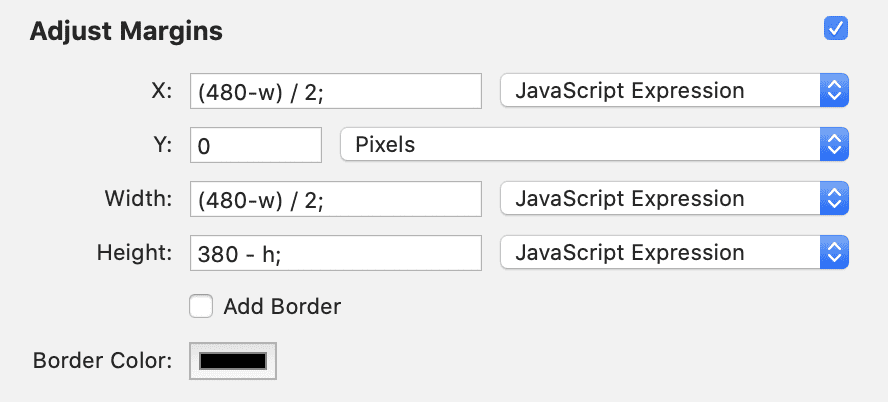
Yes, this is an oddball (and very real) case- but there's a billion of these little oddball cases out there. With the new JavaScript expressions support, these small but hard to do scenarios are now super easy.
And yes, all of the JavaScript support in Retrobatch now sits atop FMJS, which any developer can use to build similar support into their apps.
What else is new?
File numbers with leading zeros for the Write node. You can add (and it's case sensitive) $FileNumber04$ in the File name: field of the Write node to have the file number of your image written out as part of the name, with a padding of up to 4 zeros. If you'd like to pad that number to 6, you would enter $FileNumber06$, and so on.
The Mask to Alpha node got a new "invert colors" option. Normally Mask to Alpha will convert the black areas of your image to transparent, and the white to opaque (with gray somewhere inbetween). With the new Invert Colors option, Mask to Alpha will now convert the white areas of your image to transparent, and keep the black opaque. This is great if you are scanning in line drawings from your own artwork, and want to make the backgrounds transparent.
This request comes up a lot in Acorn as well. Previously you'd have to add an Invert Colors node (or filter for Acorn), then the Mask to Alpha, and then Invert Colors again. Now it's just a checkbox in Mask to Alpha, which is super easy. I've also added an update to the same filter in Acorn for the next release. You can grab a preview of it from here.
And finally for my short list, you can now make a droplet which doesn't take any files. Why is this useful? Well, imagine you have a workflow that reads an image from the clipboard, resizes it to a specific width, and then writes it back to the clipboard. Now you can make a little droplet to do just this. Just a double click from the Finder (or a single click from the Dock) and your workflow is run.
The full release notes for Retrobatch 1.4 are available in the usual place.
* ./bin/otbuild.sh -e 1.4
Normality in Melbourne: How They Took a Coffee Break
In a lane of course. It’s a Melbournesque scene, and you have to know where to find it. Apparently the knowledge workers who serve tech, law and business in the nearby towers don’t really care whether there’s seating. (Click above for image.)
Takeaway coffee is sold from a window that was possibly cut into the concrete, or maybe provided light to the rear of a commercial building. What once might have been storage is now high-performance retail.
The menu is limited, but the choice isn’t. The coffee experience at ‘The Patricia’ is distinctly curated; the staff are knowledge friendly.
It’s very good.
Apple rumoured to announce iPhone SE 2 on April 15

New information points to Apple releasing its often-rumoured entry-level iPhone 9 — also sometimes known in leaks as the iPhone SE 2 — on April 15th, with the device shipping on April 22nd.
This rumour comes from YouTuber Jon Prosser and his ‘Front Page Tech channel.’ Prosser claims Apple recently held internal meetings regarding the iPhone 9’s release date.
While Prosser’s record when it comes to leak accuracy is unclear — on March 26th Prosser also said a similar iPhone 9 briefing was happening — this does line-up with similar information sourced from reliable Apple analyst Ming-Chi Kuo. Kuo has previously stated he expects Apple’s entry-level iPhone to release in the first half of 2020.
iPhone 9 update
Per an internal meeting yesterday, Apple is now preparing for an April release.
Tentative dates:
– Announcement on April 15
– Shipments on April 22Keep in mind: we’re in the middle of a pandemic, and things could change.
Fingers crossed
pic.twitter.com/egz8UWXd9F
— Jon Prosser (@jon_prosser) March 31, 2020
That said, what Apple’s upcoming entry-level iPhone will actually be called still remains unclear.
Some rumours point to it being named the iPhone 9, which seem dubious given the number 9 indicates the phone is lesser than 2017’s iPhone X. Other information points to Apple sticking with the relatively well-known iPhone SE name and adding a ‘2’ to it.
With all that in mind, given the first iPhone SE launched way back in 2016, Apple will likely opt for an entirely different name.
The iPhone 9/iPhone SE 2 has been rumoured for years. The smartphone is tipped to feature Touch ID and reportedly adopts a look similar to the iPhone 8 and iPhone 8 Plus.
If these rumours regarding the iPhone 9’s release date are accurate, this would mean the recent COVID-19 pandemic has not pushed back the smartphone’s release like some expected.
Given April 15th is only a few weeks away, we won’t have to wait long before we learn more about Apple’s next smartphone.
Source: @Jon_Prosser, Front Page Tech Via: Apple Insider
The post Apple rumoured to announce iPhone SE 2 on April 15 appeared first on MobileSyrup.
Life under Covid 19, week 2.5
A few pictures from the past week in chronological order
Social distancing is now the norm at grocery stores.

After reading numerous stories about the shortage of critical supplies at hospitals, including our local St. Joes, I decided to donate a container of lysol wipes that I got on the shopping trip pictured above, as well as most of a container of surgical masks that I had bought a week ago in Chinatown. On the way down, I biked along the Queensway to remind myself about the section of bike lane that is due to be improved. Here is the eastbound bike lane ending short of Claude Ave. It is truly unfortunate that the bike lane will not be extended all the way to Roncesvalles. The planning document says something about insufficient road width. At least there will be a significant reconstruction of the Roncy/Queen/King intersection that will make things safer for pedestrians and cyclists that alight from the MGT by crossing the pedestrian/bike bridge across Lakeshore.

The bike lane will be extended one block east to Glendale Ave, where there is a stoplight and pedestrian crossing. Right now, there are sharrows leading up to this intersection. It is truly unfortunate that the bike lane will not be extended all the way to Roncesvalles. The planning document says something about insufficient road width. At least there will be a significant reconstruction of the Roncy/Queen/King intersection that will make things safer for pedestrians and cyclists that alight from the MGT by crossing the pedestrian/bike bridge across Lakeshore.

Here I am just before dropping off the supplies, which were accepted gratefully. They said I should have emailed ahead of time, but I think they took pity on me because I had obviously biked in.

Today I had to run an errand to U of T, which was a ghost town.

In the lineup at PAT Central Market on the way home.

Also went by No Frills, where I hit the toilet paper jackpot. Always good to have a pair bungee cords in your panniers, just in case.

Stay safe and sane, everyone.

I don’t see any clear indication of the flattening of the curve for either the US or Canada. It’s going to be a long haul.
Professor Pete's Philosophy 1010
Oliver has been auditing Philosophy 1010 (Introduction to Philosophy) at the University of Prince Edward Island this semester. When the university closed for COVID-19, classes paused for a week and then, in theory, resumed after academics came up a plan for “transitioning to alternative course delivery.”
In the case of Philosophy 1010, alternative course delivery consisted of “here are my notes for the lectures I would have otherwise have given you.” You know, like when Broadway closed, and they handed out the scripts to the patrons so they could perform the shows themselves.
This left Oliver, who appreciates the performative aspects of the university lecture more than anything else, feeling substantially under-served, and left me in the position of having to rush to fill the void.
Unfortunately I took the other philosophy course during my brief tenure as an undergraduate, the “logic course,” where we spent our days in Venn diagrams rather than reading Plato. Leaving me ill-prepared for the task ahead. But I rallied.
Last week’s topic: Personal Identity.
Using the text as our guide, I sketched the four notions of identity, and then we fleshed them out together, using real world examples from our friends and familiars. When someone loses their leg in a war, for example, do they become a different person? What about someone who transitions to a different gender? Does someone who wasn’t diagnosed autistic become a different person if they receive an autism diagnosis? Do Buddhists really have no personal identity? This is where we ended up:
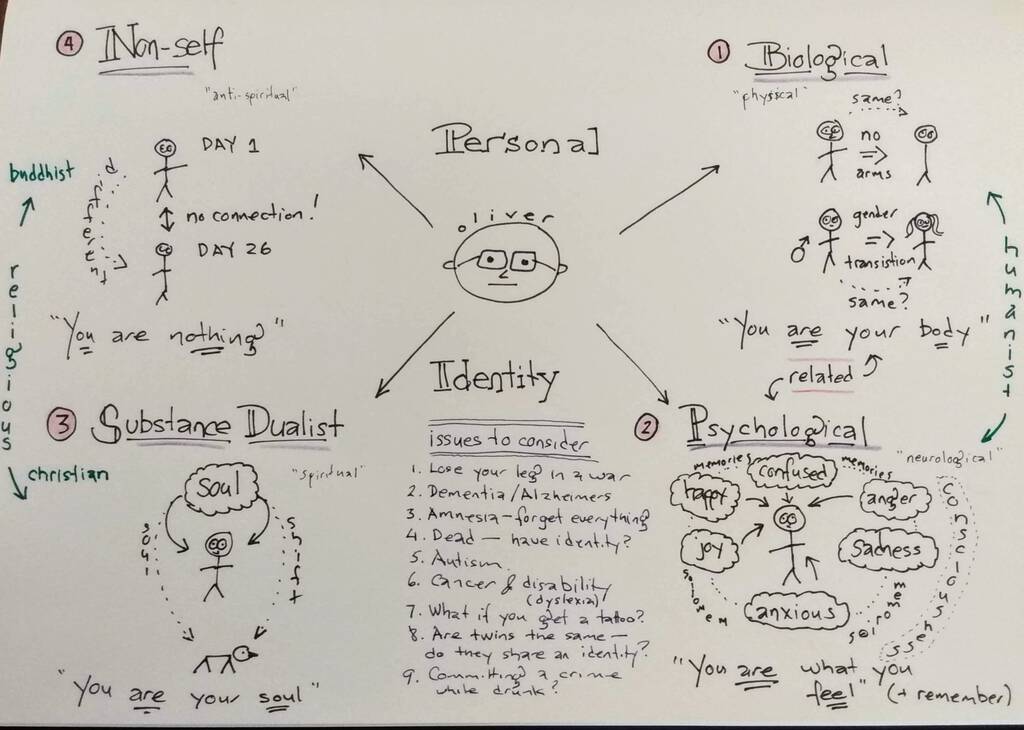
Today’s topic: Does God Exist?
This is the concern of the first chapter of the text, but the last to be considered in the course. Oliver was particularly engaged in this topic, and I was woefully ill-equipped to provide anything but the barest details, having spent approximately 5 minutes over 53 years on my own considerations of whether or not God exists. But it was fun nonetheless.
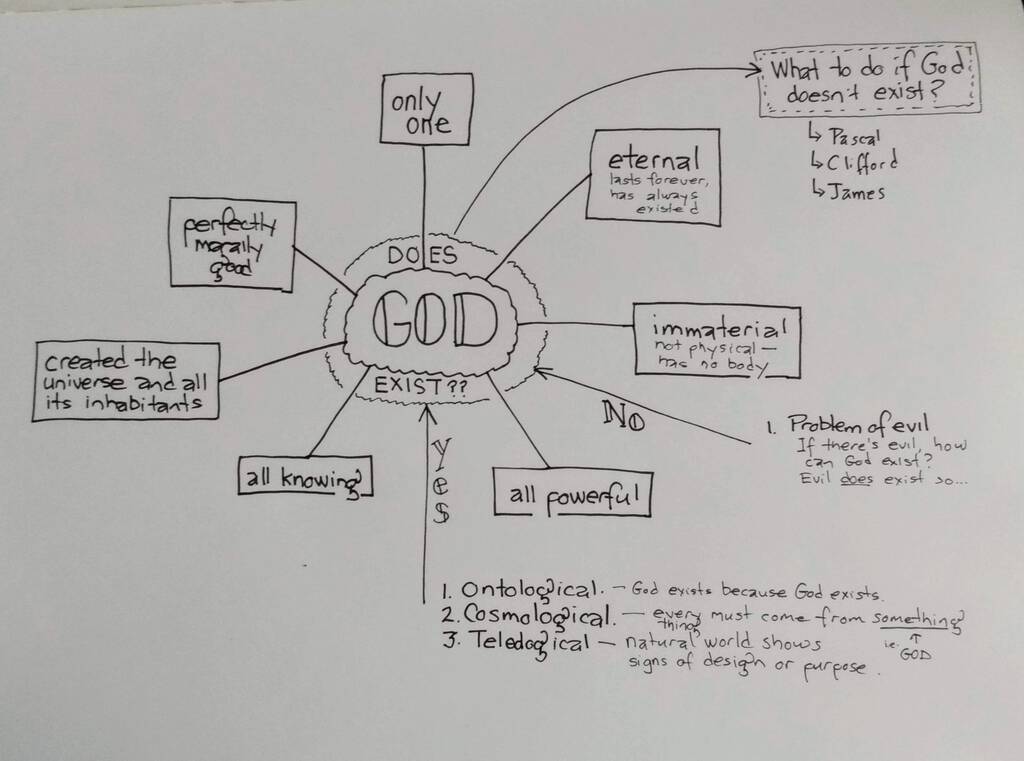
Oliver emailed our sketch of Does God Exist? to his professor and got some helpful commentary, so all was not lost on the formal front.
For typical students, all that’s left now is the final exam, the alternative delivery of which will be by email as a take-home project, with a pleasant degree of humour:
What I will do, instead, is post the exam here on moodle on Tuesday, April 14, thus giving you FOUR DAYS to complete it.
Please note: the test is not geared to take four days. The test is still geared to take 3 hours. The added time is merely to offset any viruses — computer or covid-19.
There was, in theory, one more lecture left, for this Wednesday, although it appears as though the class proper will not consider it. Oliver and I, regardless, will meet on Wednesday to ponder Paley’s Design Argument and Pascal’s Wager.
213 – 215 East Cordova Street

This 1927 image shows the new premises of the Tairiku Nippo Sha, or Continental Daily News, a Japanese language newspaper that started publication in 1907. There’s a cartouche with the initials ‘TNS’ on the upper part of the building. As Japantown, centered on Powell Street, grew and prospered, the newspaper was able to move into modern accommodation.
Patrick Gunn from Heritage Vancouver tracked down the building permit; it was approved in April 1927, and the business seem to have moved here in August that year. Gardiner & Mercer were the architects of the building with an unusual combination of recessed balcony and a Mission style roof. Moncrieff & Vistaunet built the $28,000 project. When the newspaper moved here it was run by “Mr. Yamasaki” Yasushi Yamazaki, who bought the Nippō in 1908 (after founder Dosa Iida ran into problems related to his attack on Japanese prostitution, and the men who controlled it). Born in Toyama in 1871, Yashudi arrived in B.C. in 1893, working as a logger, fisherman and miner. He was Secretary of the Japanese Fishermen’s Union in Steveston in 1900 and active in the Japanese fishermen’s strike. In the 1901 census he was listed as Y Yamasaki, a lodger, working as a laborer.
He began publishing a newspaper in Seattle in 1902 before returning to publish the Vancouver paper. Far from backing down from challenging the Japaeses sex trade, Yashudi continued the campaign against the prostitution of Japanese women, including publishing their pictures in a book published by the newspaper. He was President of the Canadian-Japanese Association from 1909-17. At the outbreak of war, hoping to get Japanese Canadians greater acceptance, and potentially the vote, he organized the Canadian Japanese Volunteer Corp (WWI). The corps of 200 was rejected as too small, but many members were accepted into the army in Alberta, and fought in Europe as Canadian soldiers. While remaining in charge of the Vancouver newspaper, from 1917-33 he was also editor of a newspaper in Japanese-held Manchuria. In the 1920s he lived on the next block, but although continuing as President of the newspaper, by 1930 he was no longer living in Vancouver. The newspaper was closed down in 1941, and Yasushi Yamazaki died in 1947 in Japan.
It appears from the street directory that the upper floor of the building might have been converted to residential use; in 1947 this address was the Mayfair Hotel Rooms (and next door were cabins, that can also be seen in the 1927 image). In 1955 the Mafair rooms were still here, with the lower floor shared by ‘Can Govt Agriculture Health of Animals’, and ‘Nifty Noodles’. By 1973 this had become the back of the new $6m Courthouse, designed by Harrison, Plavsic and Kiss.
0960
7 Great Budget Bikes You Can Buy on Amazon in 2020 – Road, Mountain, Cruiser, Hybrid and Comfort Bikes
 Reviews, comparative chart, and videos to tell you all about 7 great budget bikes you can buy on Amazon, including Cruisers, Mountain bikes, Hybrid bikes, Road Bikes, and Comfort Bikes. Take advantage of Amazon's excellent delivery and return policies to buy a cheap bike without anxiety. Plus, some reputable brand name bikes are now available on Amazon, so there are some great options available. Post includes Pro Tips on how to buy bikes from Amazon.
Reviews, comparative chart, and videos to tell you all about 7 great budget bikes you can buy on Amazon, including Cruisers, Mountain bikes, Hybrid bikes, Road Bikes, and Comfort Bikes. Take advantage of Amazon's excellent delivery and return policies to buy a cheap bike without anxiety. Plus, some reputable brand name bikes are now available on Amazon, so there are some great options available. Post includes Pro Tips on how to buy bikes from Amazon.
The post 7 Great Budget Bikes You Can Buy on Amazon in 2020 – Road, Mountain, Cruiser, Hybrid and Comfort Bikes appeared first on Average Joe Cyclist.
gifcap
This is really neat: a purely client-side implementation of animated gif screen capture, using navigator.mediaDevices.getDisplayMedia for the screen capturing, mithril for the UI and the gif.js pure JavaScript GIF encoding library to render the output.
Via Hacker News
Eidos Montreal to donate ‘Deus Ex’ Steam proceeds to Food Banks of Quebec

Square Enix-owned developer Eidos Montreal has pledged to donate proceeds of its Deus Ex games to the Food Banks of Quebec in response to the COVID-19 pandemic.
As part of this campaign, a handful of Deus Ex titles have been discounted, with all proceeds of the sales of these games between March 30th at 12am ET and April 2nd at 2:59am ET going towards the Quebec charity.
The following Deus Ex games are included in this event:
- Deus Ex: Game of the Year Edition — $1.09 CAD (regularly $7.79)
- Deus Ex: Invisible War — $1.09 CAD (regularly $7.79)
- Deus Ex: Human Revolution — Director’s Cut — $3.29 (regularly $21.99)
- Deus Ex: Mankind Divided — $5.24 (regularly $34.99)
It’s worth noting that Deus Ex and Deus Ex: Invisible War — the first two games in the cyberpunk action series — were developed by the now-dissolved Austin, Texas-based Ion Storm. Eidos Montreal, meanwhile, developed Human Revolution and Mankind Divided, the franchise’s most recent entries.
According to the Food Banks of Quebec, more than 400,000 people in the province suffer from hunger every month — a fact that’s no doubt only made worse by the ongoing global health crisis.
If you want to get some great games on sale while supporting a good cause, you can check out the Deux Ex Steam sale here.
The post Eidos Montreal to donate ‘Deus Ex’ Steam proceeds to Food Banks of Quebec appeared first on MobileSyrup.
The Best Security Key for Multi-Factor Authentication

A good password manager is the first step to online security but not the last. Enabling two-factor authentication on your accounts is the next step, and using a physical security key is the most secure way to do so. The Yubico YubiKey 5 Series has the best combination of compatibility, usability, and security of any key we tested.






